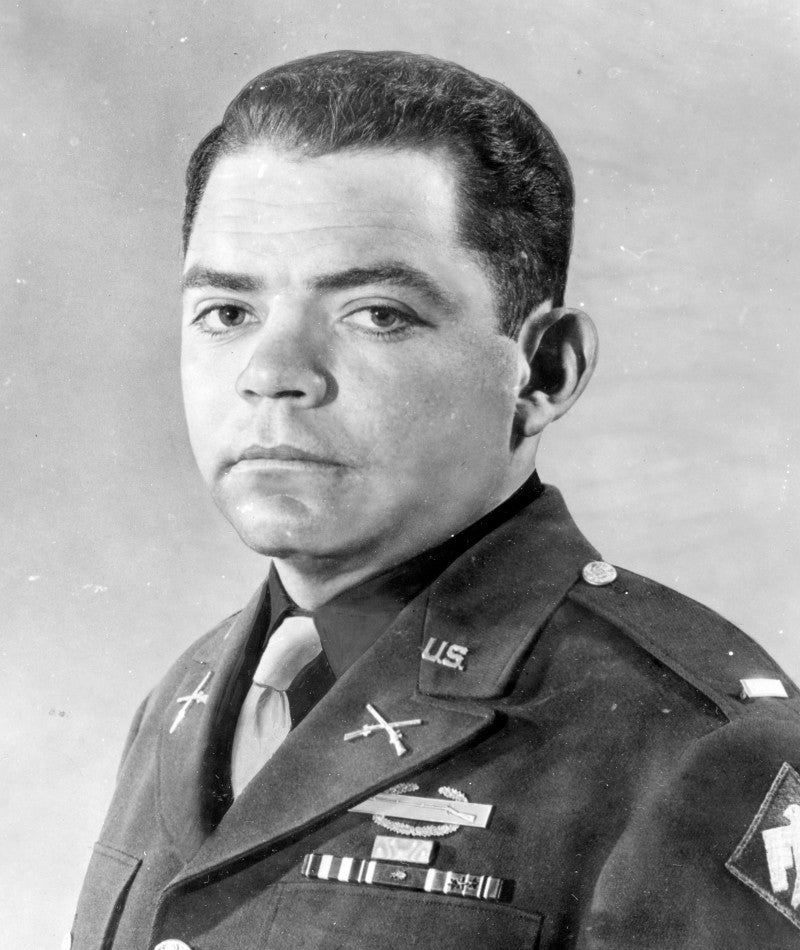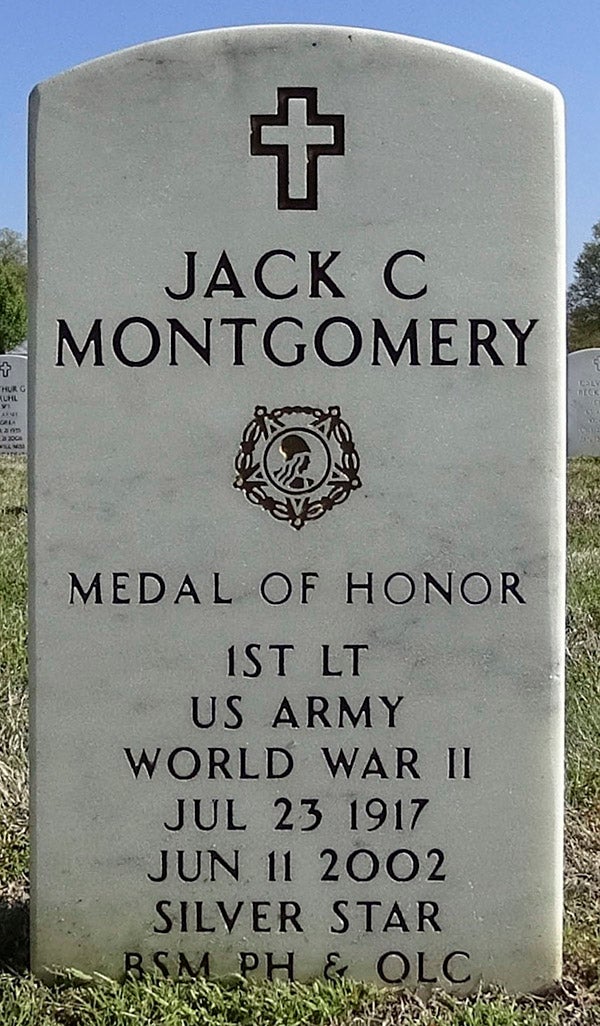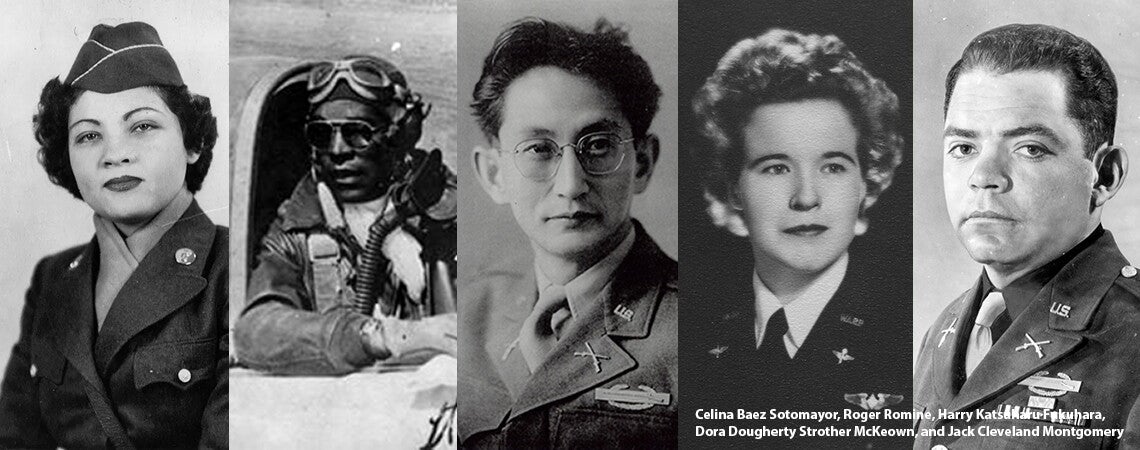Jack Cleveland Montgomery: Peace to War and Back Again
by Tom Holm
 Few combat veterans have seemingly overcome the trauma that comes with their terrifying, horrific experiences. Most, in fact, suffer from the mild to severe effects of Post Traumatic Stress Disorder (PTSD), and undergo flashbacks, attacks of anxiety and depression, rage, isolation, sleep intrusions, and exaggerated startle responses. In some cases, these symptoms lead to social problems such as drug and/or alcohol abuse or the inability simply to “get along” with other people. PTSD is very possibly the result of survivor guilt, the witnessing of death, the stress of being under the threat of violent death, as well as seeing friends being maimed or killed. These facts are not in dispute, and presumably have a history dating back to the time when human beings first went to war with each other. For more than a hundred years, PTSD has been called, variously, “battle fatigue,” “the thousand-yard stare,” and “shellshock.”
Few combat veterans have seemingly overcome the trauma that comes with their terrifying, horrific experiences. Most, in fact, suffer from the mild to severe effects of Post Traumatic Stress Disorder (PTSD), and undergo flashbacks, attacks of anxiety and depression, rage, isolation, sleep intrusions, and exaggerated startle responses. In some cases, these symptoms lead to social problems such as drug and/or alcohol abuse or the inability simply to “get along” with other people. PTSD is very possibly the result of survivor guilt, the witnessing of death, the stress of being under the threat of violent death, as well as seeing friends being maimed or killed. These facts are not in dispute, and presumably have a history dating back to the time when human beings first went to war with each other. For more than a hundred years, PTSD has been called, variously, “battle fatigue,” “the thousand-yard stare,” and “shellshock.”
Jack C. Montgomery, a citizen of the Cherokee Nation, although he had seen combat, death, and had been wounded twice himself in World War II, returned to his home and was seemingly devoid of emotional problems associated with PTSD. The question is why. He certainly was subjected to the trauma associated with participation in combat and was equally exposed to the historical and collective trauma of being a Cherokee.
In fact, Montgomery lived an almost storied life, coming from a small town in one of the most impoverished counties in Oklahoma to becoming a national hero and finding employment in an institution devoted to serving war veterans like himself. Montgomery’s life after the war stands in stark contrast to, for example, that of Ira Hayes, the Akimel O’odham Marine who helped raise the flag on Iwo Jima, captured in Joe Rosenthal’s photograph that won the Pulitzer Prize and was the model for the Marine Corps Memorial in Arlington.
Montgomery and Hayes had similar life experiences. Both came from impoverished communities; both were athletic; both went to Native American boarding schools; both were staunch in their belief in the American crusade during World War II; both saw death and destruction on the battlefield; and both were seen as heroes. Equally, the two men professed a basic belief in the Christian religion, even while holding on to some of their traditional tribal sense of identity.
Where they differed was in their levels of education, their branches of service, and the places in which they fought. Montgomery had a college education, was in the Army, and fought in the European Theater. Hayes had a high school education, was a Marine, and fought in the Pacific. And where they remarkably differed was in what they did after the war.
While Hayes moved from job to job and became a binge drinker like many laborers in that period, Montgomery was steadily employed and drank in moderation. Hayes died at age thirty-two; Montgomery lived until the relatively old age of eighty-four. In the end, those were the experiences that set them apart. Those, and Jack Montgomery’s apparent scarcity of symptoms associated with PTSD.
Jack Cleveland Montgomery was born in Long, Oklahoma, in 1917. The town itself was founded within the boundaries of the Cherokee Nation before it was subjected to the splitting up of its lands into individually held plots under the Curtis Act of 1898. The Montgomery family moved to Cushing, Oklahoma, when Jack was four. He started school in Cushing, but at the age of thirteen was sent to Chilocco Indian School near the border with Kansas. After his tenth year of schooling, he went to high school in Carnegie, Oklahoma, in the southwestern part of the state. He graduated in 1936 and went to the all-Native Bacone Junior College in Muskogee. There, he played football and attended classes for two years. After Bacone he was given a football scholarship to Redlands College in California. He earned a physical education degree in 1940 and returned to Muskogee.
Montgomery’s military career began in 1935 while he attended Carnegie High School. That summer he went to the Citizen’s Military Training Camp at Fort Sill, which was situated approximately thirty-five miles from Carnegie. The CMTC began under the National Defense Act of 1920 as an alternative to mandatory universal military training. A significant portion of the armed forces command structure as well as numerous politicians were concerned about the lack of military preparedness that had preceded America’s entry into World War I. As a compromise, the Defense Act established the CMTC for young men to receive military training during the summer months with the possibility of entering the service and becoming officers. The program began in 1921 and was discontinued in 1940, during which time some 400,000 young men attended the camps.
When Montgomery entered Bacone he not only played football but also enlisted in Company I, 180th Regiment, 45th Division of the Oklahoma National Guard. He was discharged when he went to Redlands. But when he returned to Oklahoma Montgomery found that his physical education degree did not qualify him to teach and so, when the 45th Division was being mobilized, he rejoined his old unit for a one-year stint. Montgomery was discharged in September 1941. In December of that year, he reenlisted after the Japanese bombed Pearl Harbor.
The 45th Division was sent to Texas, then to Massachusetts, New York, and Virginia, for further training. In June 1943 the division embarked for North Africa. They offloaded near Oran, in Algeria, then a French colony that surrendered as a result of the American and British campaign against the Nazi general Erwin Rommel’s Afrika Corps. The next month the 180th became part of the assault force in Operation Husky, the invasion of Sicily. By then the Army had learned the art of seaborne assaults. This kind of assault was a tactical movement from a ship to a particular objective. It differed from the kinds of landings that took place during World War I in that those operations, like the one at Gallipoli, Turkey, simply landed the attacking force on the beach only then to dig in and plan out operations from that point on a wide front. The Gallipoli landings eventually turned out to be a disaster and American planners worked out a different approach to seaborne landings during World War II.
Montgomery’s unit was assigned the task of taking an airfield at Biscari, Sicily. His platoon landed and made a beeline toward the objective. Heavy fighting ensued, oftentimes hand-to-hand. His participation in this battle led to his combat promotion to 2nd lieutenant, a Purple Heart, and a Bronze Star. The assault on Sicily was a prelude to the invasion of Italy.
Lieutenant Montgomery and his platoon were held in reserve while the 45th came ashore at Salerno, Italy. In mid-September, Montgomery’s Company I came ashore and proceeded directly north to Benevento. During the fighting around and in the town, Montgomery exposed himself to German fire and led his platoon through heavy fighting. He was awarded the Silver Star for bravery in the action. The Germans, fearing that Italy would withdraw from the fighting or simply surrender to the Allied forces, heavily reinforced their already large fighting contingent in the Italian boot. As the 45th slowly moved up the eastern shore it suffered heavy casualties in combat. The advance ground to a halt by the end of 1943.
At that point, the Allied forces devised a plan to flank the Germans and hopefully begin an assault on Rome itself. Another seaborne assault was made on Anzio beach some forty miles directly south of Rome. The landing was made in January 1944 and was relatively unopposed. Within days the beachhead was secure and the Americans began to fan out from Anzio. However, the Germans had devised a plan to let the Americans land and then attack them in force, cutting off the spearhead of the inevitable attack on Rome. The Germans hit the beachhead with heavy artillery attacks followed by German infantry advances. The 45th was again engaged in another high-casualty slugfest.
On February 22, the Germans set up a three-position defensive force directly opposing Montgomery’s platoon of about twenty soldiers. Lieutenant Montgomery ordered his platoon to put down a base of covering fire, while he alone attacked the first echelon of the German force. His foray resulted in killing eight Germans while capturing four. He returned the POWs to his own line and called in an artillery strike. He attacked the rest of the Germans who had pulled back to a local farmhouse. Alone, Montgomery killed three more Germans and captured twenty-four more. That night, while in a defensive position, his platoon came under an intense mortar attack. Montgomery was severely wounded in the legs, back, and chest with shrapnel. He was evacuated to a rear area medical facility and then to an Army hospital. Montgomery was shipped back to the US where he underwent several operations to repair and heal his wounds.
After recovering from his injuries, Montgomery was sent to Camp Wolters in Texas, where he became an infantry training instructor. While there he was called to Washington, DC, to receive the Medal of Honor from President Franklin D. Roosevelt. He left the Army in September 1945 and went to work for the Veterans Administration (VA) the very next year.
 While with the VA, Montgomery served in area offices in Bartlesville, Hugo, and Muskogee, Oklahoma. Throughout his life his modesty prevented him from flaunting his service record and the fact that he had won the nation’s highest award for bravery, the Medal of Honor. Still, he was honored again and again. The state of Oklahoma commissioned a portrait of Montgomery that now hangs in the 45th Division Museum. In 1946, the Italian government awarded its Cross of Valor to him, and the Cherokee Nation honored Montgomery with a bench inscribed with his name at the nation’s war memorial in Tahlequah, Oklahoma. He died in 2002 at the age of eighty-four and is interred at Fort Gibson National Cemetery in Fort Gibson, Oklahoma. The Jack C. Montgomery Veterans Affairs Medical Center in Muskogee is named for him.
While with the VA, Montgomery served in area offices in Bartlesville, Hugo, and Muskogee, Oklahoma. Throughout his life his modesty prevented him from flaunting his service record and the fact that he had won the nation’s highest award for bravery, the Medal of Honor. Still, he was honored again and again. The state of Oklahoma commissioned a portrait of Montgomery that now hangs in the 45th Division Museum. In 1946, the Italian government awarded its Cross of Valor to him, and the Cherokee Nation honored Montgomery with a bench inscribed with his name at the nation’s war memorial in Tahlequah, Oklahoma. He died in 2002 at the age of eighty-four and is interred at Fort Gibson National Cemetery in Fort Gibson, Oklahoma. The Jack C. Montgomery Veterans Affairs Medical Center in Muskogee is named for him.
Like a Cherokee ugvwiyuhi (chief) of old, Jack Montgomery lived life with the traits or virtues that seemingly went along with leadership. He was generous, courageous, honest, and, most of all, humble. He also appeared to have had a life that was free of the trauma that combat veterans suffer in large numbers. He saw the worst of combat: the deaths of friends and foes, the destruction of infrastructure, and the sounds and smells of the battlefield. He was also forty percent disabled due to his wounds.
There was only one incident in his life that hinted at possible trauma and the problems associated with it. In 1958, while working for the Veterans Administration in Bartlesville, he was charged with public drunkenness and the destruction of city property. Nothing came of his arrest, and he went back to his job without a problem except, perhaps, getting admonished. Other than this episode, nothing suggests that Montgomery suffered any of the hallmarks of PTSD.
In 1996, I published a book titled Strong Hearts, Wounded Souls. I surveyed and interviewed a number of Native Vietnam Veterans and found that their participation in cleansing and/or honoring ceremonies among their people mitigated somewhat the symptoms of PTSD. These ceremonies helped the veterans cross back over the line from war to peace, from chaos to stability. Sebastian Junger, in his 2016 book Tribe: On Homecoming and Belonging, supports this idea and essentially argues that returning combat veterans need the sense of belonging that they felt in the bonds developed while in their platoons. Junger extracts this meaning from a look at tribal life and the surviving tribal ceremonies intended to heal the combat veteran.
Jack Montgomery might not have participated in time-honored Cherokee healing ceremonies, but it is known for certain that he continued to feel the sense of belonging in his work with other veterans. The honors he received and the security of a strong family life no doubt helped him cross that line between war and peace and back again. It was a kind of social absorption of wartime trauma. His whole life was spent in service to his community of war veterans like himself. His tribal virtues of courage, honesty, generosity, and humility were honored by those around him. In short, from the time he entered the Army to his retirement from the Veterans Administration, he must have felt his responsibility to the relationships he had with his fellow warriors. His identification with a group having similar experiences contributed to his own healing.
Tom Holm (Creek/Cherokee) is professor emeritus of American Indian studies at the University of Arizona. He is the author of Ira Hayes: The Akimel O’odham Warrior, World War II, and the Price of Heroism (Twelve Books, 2023) and Code Talkers and Warriors: Native Americans and World War II (Chelsea House Publishers, 2007).
Bibliography
“Back on the Peninsula.” Nashville Banner, Tennessee (November 4, 1952), p. 14.
Bean, Christopher B. “Jack C. Montgomery: A Little Big Man.” Chronicles of Oklahoma 82, Issue 4 (Winter 2004–2005), pp. 476–495.
“Captain Savage Is County Chairman C.M.T.C. Ft. Sill.” Daily American-Democrat, Anadarko, Oklahoma, July 1, 1936, p. 1.
“Disability Protection Plan Is Now Available In Veteran Insurance.” Miami News-Record, Miami, Oklahoma, January 5, 1959, p. 2.
“Extra Money May Upset VA Pension.” Tonkawa News, Oklahoma, June 26, 1961, p. 1.
Franco, Jeré Bishop. Crossing the Pond: The Native American Effort in World War II. Denton: University of North Texas Press, 1999.
“Hero Takes on Enemy in Three Attacks.” Anadarko Daily News, Oklahoma, November 10, 1963, p. 1.
Holm, Tom. Code Talkers and Warriors: Native Americans and World War II. New York: Chelsea House, 2007.
_______. Ira Hayes: The Akimel O’odham Warrior, World War II, and the Price of Heroism. New York: Twelve Books, 2023.
_______. Strong Hearts, Wounded Souls: The Native American Veterans of the Vietnam War. Austin: University of Texas Press, 1996.
Infield, Tom. “Medal Of Honor Winner Hero Still Monumental Figure in Muskogee.” Sunday Oklahoman, January 23, 1994, p. 12.
Junger, Sebastian. Tribe: On Homecoming and Belonging. New York: Twelve Books, 2016.
Kington, Donald M. Forgotten Summers: The Story of the Citizens’ Military Training Camps, 1921–1940. Two Decades Publishers, 1995.
Kouts, Vernon. “Citian To Take Part in Honor Ceremonies.” Muskogee Daily Phoenix and Times-Democrat, Oklahoma, November 9, 1962, p. 3.
“Lieut. Jack C. Montgomery Awarded Italian Cross of Valor for War Service.” Muskogee Times-Democrat, Oklahoma, July 9, 1946, p. 2.
“Lt. Montgomery Awarded Silver Star.” Sequoyah Times, Sallisaw, Oklahoma, June 2, 1944, p. 1.
“Medal of Honor Winner dies at 84.” The Daily Oklahoman, June 14, 2002, p. 39.
“Medal of Honor Winner To Attend Alum Reunion.” Carnegie Herald, Oklahoma, March 27, 1963, p. 1.
“Police Court.” Bartlesville Examiner-Enterprise, Oklahoma, April 20, 1958, p. 2.
“Retirement Pay Sought for 45th Division Hero.” Enid Morning News, Oklahoma, March 20, 1954, p. 2.
Smith, Marilyn. “Muskogeean Among Congressional Medal of Honor Holders.” Muskogee Daily Phoenix and Times-Democrat, Oklahoma, September 30, 1962, Section 2, p. 1.
West, C. W. “Dub.” “Only in Oklahoma.” Sequoyah Times, Sallisaw, Oklahoma, June 2, 1944, p. 2.



